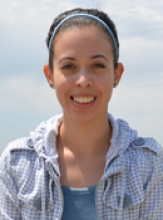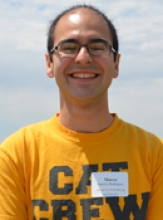Rubi Almanza
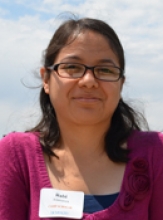 |
Major: Applied Mathematics
Home City: Planada, CA
Contact: ralmanza2@ucmerced.edu
Faculty Mentor: Professors Roummel Marcia and Suzanne Sindi
|
Rubi Almanza is a fourth-year undergraduate student in applied mathematics with an emphasis in economics and a minor in natural sciences education. She expects to graduate in Spring 2014. At UC Merced, she is the co-founder and coordinator of the Readying Intellectual Students Everywhere Program, which focuses on providing informational workshops about higher education to high school students from the area. Her work in this program is the result of her participation in the Latino Leadership Initiative at the Harvard Kennedy School last summer. Being a part of the RISE Program has allowed Rubi to practice the leadership skills she learned at LLI and give back to her community, which she is very passionate about. Rubi is a first-generation college student who wishes to serve as a role model to her family by being the first to obtain a bachelor’s degree in science.
Gradient Based Optimization for Structural Variation Discovery
Rubi Almanza, Shawn Belloso, Natalie Azevedo, Ramiro Navarrete, Professor Suzanne Sindi and Professor Roummel Marcia, applied mathematics
The human genome, a sequence of more than 3 billion nucleotides, defines the complete DNA sequence of an individual. We are only beginning to understand the genetic basis for the difference in characteristics between individuals. Recently, structural variants (SVs) such as deletions, duplications, insertions and inversions are thought to be important contributors to phenotypic variation. Identifying the SVs present in a single individual is challenging because examination of an entire genome is not possible; in fact, current technology limits DNA sequencing to small fragments. Recently, the declining cost of DNA sequencing has enabled the sequencing of thousands of individual genomes. These data sets represent an important resource for cataloging human genetic diversity; however, most methods for predicting SVs are not designed to simultaneously analyze many individuals because of the complexity of the solution space. We present a novel approach for predicting SVs in the genomes of multiple individuals. We utilize gradient-based optimization to determine the SVs present in each individual. Importantly, our approach is capable of representing the relatedness of individuals in a study to constrain the set of possible solutions and increase the prediction accuracy. Our approach represents a significant improvement for structural variants detection methods, as relatedness of individuals has not been considered before. Furthermore, our model will be useful for the study of populations and the identification of relation between individuals not seen before.
Ana Arteaga
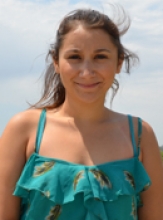 |
Major: Chemical Sciences
Home City: Merced, CA
Contact: aarteaga@ucmerced.edu
Faculty Mentor: Professor Rudy Ortiz
|
Ana Arteaga is a fourth-year chemistry student. She conducts research under the guidance of Professor Rudy Ortiz, and previously worked in Professor Erik Menke’s lab. After graduating from UC Merced, Ana wants to continue her education and obtain a Ph.D. in medicinal chemistry. Ana is the first in her family to attend college. Her inspirations are her sisters and she wants to be a good role model for them. She constantly encourages them to go to college and get an education. Ana’s pastimes include running, rock climbing and hiking. Ana's research project was made possible by funding from the USDA Research and Mentoring in Agricultural Sciences HSI Scholars Program.
Optimizing High-Performance Liquid Chromatography Method for Measuring Plasma and Organ Angiotensin II from Insulin Resistant Rats
Ana L. Arteaga, Andrew Y. Lee, Ruben R. Rodriguez, Jacqueline Minas and Professor Rudy M. Ortiz, Molecular Cell Biology group
Angiotensin II (Ang II) is the principal hormone of the renin-angiotensin system (RAS), and is up-regulated during insulin resistance and metabolic syndrome. To better assess the contribution of increased RAS on the development of insulin resistance, comprehensive analyses of tissue (plasma and organ) levels of Ang II is necessary. While antibody-derived methods are common for measuring many hormones, there are many advantages to measuring by high performance liquid chromatography (HPLC) including smaller sample volumes or amounts and increased accuracy and sensitivity. For this study, tissues were collected from three groups of rats (n = 5-6/group): 1) lean, strain control Long Evans Tokushima Otsuka (LETO), 2) untreated insulin resistant Otsuka Long Evans Tokushima Fatty (OLETF) rat, and 3) OLETF + angiotensin receptor blocker (ARB; 10 mg olmesartan/kg/d x 6 weeks). We hypothesized that measurements by HPLC will provide better analytical refinement of tissue Ang II than measures by traditional antibody methods. In the 2012 study the LETO kidney Ang II levels were 176±8 fmol/g compared to the 2011 Ang II levels 158±23 fmol/g. This same trend appears between the two studies in the plasma Ang II levels (189±45 vs 67±4 fmol/ml). HPLC measurements are currently in progress.
Fredy Cisneros
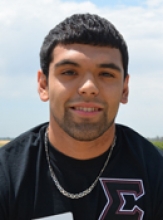 |
Major: Mechanical Engineering
Home City: Dos Palos, CA
Contact: fcisneros@ucmerced.edu
Faculty Mentor: Professor Sayantani Ghosh
|
Fredy Cisneros is a third-year undergraduate student in mechanical engineering with minors in applied mathematics and management. He expects to graduate in Spring 2015. Fredy has efficiently spent his college years maximizing his college experience. As a freshman, he was a founding member of the Theta Chapter of Sigma Delta Alpha Fraternity Incorporated while maintaining his academic standing on both the Dean’s and Chancellor’s lists. Fredy's research project was made possible by funding from the USDA Research and Mentoring in Agricultural Sciences HSI Scholars Program.
Exploring the Lasing Threshold of CdSe/ZnS Quantum Dots (QD) in 4-Cyano-4'-pentylbiphenyl (5CB) Liquid Crystal (LC)
Fredy M. Cisneros, Andrea Rodarte and Professor Sayantani Ghosh, School of Natural Sciences
Semiconductors on the nanometer scale known as Quantum Dots have been gaining popularity since their discovery in the early 1980s. In laser technology, we make use of their electronic characteristics to implement them as the active laser medium. By tuning their size and shape one can control their emission frequency thus making lasers at multiple frequencies. In this project, we fabricate LCs doped with QDs to investigate the minimum power needed for the QDs to lase. QDs do not disperse easily throughout the LC because they are very big compared to LCs. This constrains us to using a very small concentration of QDs in our samples. Currently, we have optically pumped our samples up to 3 watts of power but have not observed any lasing from the QDs nor any phase changes have occurred in the LC. The next step will consist of increasing both the excitation power and the concentration of the QDs. If we manage to make the QDs lase, we will be a step closer to creating smaller, lighter, and economically fabricated lasers that do not require any cooling and operate at room temperature.
Larrisha Coney
 |
Major: Biological Sciences
Home City: Oakland, CA
Contact: lconey@ucmerced.edu
Faculty Mentor: Professor Jennifer Manilay
|
Larrisha Coney is a fourth-year student majoring in developmental biology with a minor in cognitive science. She hopes to research speech restoration for people with brain damage to Broca’s area or other language facilities. Larrisha is fascinated with exploring biology-related phenomena and has researched cell response and signaling in the immune system. Larrisha expects to graduate in Spring 2014. She will be the first person in her family to attend and graduate from the University of California. Larrisha also held executive positions in student organizations such as the National Society of Black Engineers and the Distinguished Ladies. While in those positions, she practiced effective time management, public speaking and community event coordinating. Larrisha enjoys exposing youth to STEM studies and thrives to be an example for her family and hometown, showing that where you come from does not determine the depth of your goals. She also enjoys spending time with her family, watching comedy TV shows from the '90s and crunchy sushi.
SOST's Impact on B Cell Development and Optimizing Zinc Fixation Methods
Larrisha Coney*, Arthur Chow*, Yvette Pellman and Professor Jennifer O. Manilay, Molecular and Cell Biology * equal contribution
The microenvironment of hematopoietic stem cells is important for development of the immune system. Without the glycoprotein sclerostin (SOST), hyperactive bone growth occurs and bone marrow cavity size decreases. Studies have shown Sost affects microenvironments that sustain B cells, however little is known of its role in B cell function. We are investigating the effect of age on B cell function in Sost-knockout (KO) mice versus control B6 mice by analyzing blood samples. We hypothesize B cell populations will be altered in absence of Sost. These studies have significant biomedical importance for gaging if current clinical trials of anti-SOST antibodies for treatment of osteoporosis may have unforeseen impacts on the immunity of B cells. Furthermore, we are testing zinc based fixation (ZBF) by analysis of fluorescent stained antibodies using flow cytometry. ZBF may optimize duration of cell use if antigenic determinants are maintained by the fixation. We are focusing on antibodies indicating stages of development in hematopoietic cell lineages. Previously fixed and fresh splenic cells obtained from B6 mice were marked for B220, CD11B, MHCII, CD45, CD4 and CD8. The cells shared similar fluorescence for all antibodies except B220. The next steps will be to test clones of antigens that displayed dissimilar fluorescence and test antibody cocktails for future application of ZBF methods to Sost-KO cells.
Krystal Cunningham
 |
Major: Material Science and Engineering
Home City: Los Angeles, CA
Contact: kcunningham4@ucmerced.edu
Faculty Mentor: Professor Masa Watanabe
|
Krystal Cunningham is a graduating senior at UC Merced in material science and engineering and does research under the supervision of Professor Masa Watanabe. She plans on pursuing a Ph.D. in aerospace engineering. Aside from school, she is passionate about working with young people and plans on working with NSBE to implement a chapter in Jamaica. Krystal's research project was made possible by funding from the PG&E Engineering Summer Scholars Program.
Constant-Force Pulling of Single–Walled Carbon Nanotubes in Toluene and Water Environments
Krystal Cunningham and Masa Watanabe, Ph.D., School of Engineering, School of Natural Sciences
Various single-walled carbon nanotubes (CNTs) were studied using molecular dynamics simulations in the GROMACS software. The main objective of this study was to understand how structures of CNTs respond to tensile stresses in the different solvent environments: water and toluene. In this study, models of various armchair and zigzag CNTs were pulled by constant forces in the x- or y-axis direction to investigate their structural deformations. The pulling simulation mimicked an atomic force microscope (AFM) pulling for CNTs along their channel axis or perpendicular to the axis. Based on the simulations conducted in this work, it was found that a greater deformation occurred in smaller armchair and zigzag models. In both environments, little deformation occurred in both types of CNTs,however, larger Zigzag CNTs remained in tact under constant forces. The overall result of this study was that deformation of CNT structures depends strongly on their chirality, but less on its environment. Our simulation results were compared to other independent studies done by G. Cao et al and H. Gao et al . Furthermore, this study will have implications for important materials science and biological subareas including utilizing carbon nanotubes therapeutically.
Enrique Alejandro Daza
 |
Major: Bioengineering
Home City: San Mateo, CA
Contact: edaza@ucmerced.edu
Faculty Mentor: Professor Jing Xu
|
Enrique Alejandro Daza is in his final year studying bioengineering and economics. He previously studied the environmental effects of nanoparticles on algae species for two years at the University of California, Merced, as well as the environmental effects on nematode gene expression at the Georgia Institute of Technology. He contributed to designing a specialized heart monitor for cardiologists at the University of Melbourne, Australia. Enrique plans to one day earn his MBA and continue into the business side of science. He enjoys lifting heavy objects repeatedly for no apparent reason. Enrique's research project was made possible by funding from the PG&E Engineering Summer Scholars Program.
Constructing a DNA Origami Scaffold for Investigations of the Group Functions of Motor Proteins
Enrique Daza1, and Professor Jing Xu2; School of Engineering, School of Natural Sciences
Motor proteins are nano-machines that drive the fundamental process of mechanical motion in cells. Multiple motors work together to deliver cellular materials, such as neurotransmitters and other signal molecules, across the spatial extent of individual cells (including neurons). Defects in motor-based motion precede diseases, including neurodegeneration, and are correlated with cancer. Utilizing recent development of programmable DNA Origami nanotechnology (1, 2), I custom designed a scaffold that is 14nm by 14.5nm by 14.5nm in size, capable of grouping up to 11 motors together in close proximity. My customized DNA Origami scaffold will enable future investigations of the group functions of motor proteins in a geometry closely mimicking that observed in cells.
Sandra Diaz
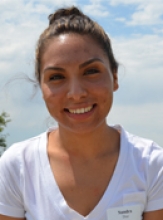 |
Major: Material Science and Engineering
Home City: Modesto, CA
Contact: sdiaz7@ucmerced.edu
Faculty Mentor: Professor Lillian Davila
|
Sandra Diaz is a fifth-year undergraduate student in material science and engineering. Her research interests include material sustainability, specifically studying the mechanical properties of an aluminum face and polyurethane foam core sandwich structure by using analytical, numerical, and experimental analysis. She expects to graduate in Spring 2014. Sandra has also participated in the UC Berkeley COINS Summer Research Program alongside Professor Keasling, specifically researching and developing a biosensor that can detect a small molecule in bacteria culture. Sandra is an advocate for women participation in the STEM field and on her spare time, she volunteers as a mentor for the Lift While You Lead women’s program that strives to promote higher education for young women. Sandra's research project was made possible by funding from CAMP and the PG&E Engineering Summer Scholars Program.
The Mechanical Properties of Sandwich Panels and Their Dependence on Foam Density
Sandra Diaz and Professor Lilian P. Davila, School of Engineering
Sandwich panels consist of two stiff materials (skins) separated by a lightweight core material. The core material effectively increases the moment of inertia of the sandwich panel with little increase in the weight, creating an efficient structure for resisting bending and buckling loads. The goal of this study is to evaluate and predict the mechanical properties of sandwich structures, consisting of two 6061 Al sheets and a polyurethane foam core, as a function of three different foam densities (32.04 kg/m3, 63.69 kg/m3, and 96.1 kg/m3). Computer simulations and analytical analysis were carried out in this project in order to create an efficient procedure for future design considerations. A Finite Element Method (FEM) program, COMSOL Multiphysics 4.3, is used to predict the load-displacement curves and stiffness of the sandwich structure when it is subjected to a three-point bending test. The results are compared with the predicted values from the analytical analysis and with previous experimental findings. Predicted results show that the stiffness increases as foam density increases, implying that the density and strength of the foam in the sandwich structure have a direct relationship, and affect the overall properties of the combined foam-sheet system. Future work will involve assessment of the feasibility of these sandwich structures as vehicle impact absorbers by conducting real experimental tests.
Maritza Flores-Marquez
Maritza Flores-Marquez is a fourth-year undergraduate student at the University of California, Merced, where she is majoring in environmental engineering with a minor in public health. She expects to graduate in Spring 2015. Her lifetime accomplishment has been to be the first in her family to attend a university. By being part of the 2013-2014 Undergraduate Research Summer Scholar’s Program, she hopes to gain vital skills that will help her in graduate school and as well as in a future in STEM. Maritza comes from a small family that taught her to value and obtain and education, because her parents were unable to attain their degrees. During Maritza’s free time, she enjoys baking, watching movies and spending time with family and friends. Maritza's research project was made possible by funding from the USDA Research and Mentoring in Agricultural Sciences HSI Scholars Program.
Ionic Strength and pH Dependence of Aqueous Cadmium and Lead Ion Sorption on Kaolinite
Maritza Flores-Marquez1, Molly Small2 and Professor Peggy A. O’Day2, School of Engineering, School of Natural Sciences
Distinguishing reactive surface area of minerals from geometric surface area can aid in accurate simulation of mineral dissolution, precipitation, mobility of nutrients, and transport of contaminants. Reactive surface area consists of the reactive sites participating in mineral surface reactions. Study of aqueous cadmium (Cd2+) and lead (Pb2+) adsorption onto kaolinite, a common clay mineral, will contribute to the quantification of reactive surface area as a function of pH and ionic strength. PHREEQC, a theoretical aqueous speciation and surface complexation modeling program, was used before experimentation to determine equilibrium conditions for a given input solution. Metal ion adsorption from PbCl2 or CdCl2 solution (5x10-5 -M) on kaolinite in a CaCl2 electrolyte solution (0.1-M or 0.01-M) was determined in 24-hour batch experiments at constant pH. After reaction, samples were centrifuged, and supernatant solution was removed and filtered. Inductively Coupled Plasma Optical Emission Spectrometry measured total Cd2+ and Pb2+ solution concentrations. Metal coverage on the kaolinite surface was determined by difference from measured solution concentration and mineral surface area. Results indicated that Pb2+ adsorption was unaffected by ionic strength (0.02-M, 0.2-M, or 0.002-M) at constant metal concentration since the final surface coverages were similar. For Cd2+, surface coverages were higher at higher metal solution concentration (4.55x10-4-M) than at lower concentration (5x10-5-M) at 0.02-M ionic strength, however, surface coverages were unaffected by ionic strength (0.02-M and 0.2-M) at constant metal concentration. The reacted kaolinite will be analyzed using Nuclear Magnetic Resonance and X-Ray Absorption Spectroscopy to quantify and describe the surface reactivity of minerals.
Carlos Gomez
 |
Major: Bioengineering
Home City: Hawthorne, CA
Contact: cgomez24@ucmerced.edu
Faculty Mentor: Professor Néstor Oviedo
|
Carlos Gomez is a fourth-year undergraduate student in bioengineering and researches planarians to gain insights into the fundamental mechanisms of stem cell regulation regarding cancer and regeneration. He is expecting to graduate in Spring 2015. Carlos has been working hard for the past couple of years to not only become the first in his family to graduate with a college degree, but the first to enter graduate school and obtain a doctorate degree. To do this, he has started challenging himself by taking on a minor in chemical sciences and joining various clubs and programs. Carlos thinks education is important, but being involved in other extracurricular activities also helps shape a person. From his extracurricular activity of long-distance running, Carlos has completed three marathons, multiple half-marathons, various cross country events, and learned about the depths of his determination and perseverance. Carlos says he was also able to accomplish these feats through the encouragement of his friends and family. He says their guidance and support helped him reach where he is today. Carlos's research project was made possible by funding from the USDA Research and Mentoring in Agricultural Sciences HSI Scholars Program.
Regional Differences in Stem Cell Proliferation and the Initiation of Cancer
Carlos O. Gomez and Professor Néstor J. Oviedo, School of Natural Sciences
Cells with DNA damage ultimately have three fates: repair the DNA, undergo apoptosis, or continue functioning with the abnormal DNA. Understanding how stem cells (SCs) with abnormal DNA continue to proliferate is crucial for gaining insight into cancer initiation. Planarians are used in this study because they contain SCs similarly regulated as the ones found in humans. SCs in planarian are known as neoblasts and these cells participate in tissue regeneration and cancer initiation along the anterior-posterior (AP) axis. These flatworms provide an excellent paradigm to track SC behavior and cellular transformation in the adult body. Specifically, we are interested in understanding how mechanisms of DNA repair and cancer initiation are different along the AP axis. We have created mutant planarians with AP abnormalities by using pharmacological treatments and genetic manipulations with RNA interference. Once the polarity was disrupted, we induced DNA damage on SCs through the use of chemical agents and irradiation. The damage is planned to be assessed by whole-mount immunostaining. From that data, we aim to determine whether SCs located in the anterior use different DNA repair mechanisms than SCs in the posterior. We expect a slight variation among the two regions based on previous evidence showing that SCs produce different structures depending on their location.
Laura Jalpa
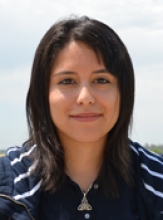 |
Major: Earth Systems Science
Home City: East Palo Alto, CA
Contact: ljalpa@ucmerced.edu
Faculty Mentor: Professor Asmeret Asefaw Berhe
|
Laura Jalpa is a third-year undergraduate student in Earth systems science who is interested in the field of soil science. She expects to graduate in Spring 2015 and attend graduate school. She hopes to also attain a Ph.D. in soil science and one day become a professor. Laura also would like to travel to other countries and do volunteer work. Laura enjoys hiking, camping and running as often as she can. On the creative side, she likes to cook and knit. Laura's research project was made possible by funding from the USDA Research and Mentoring in Agricultural Sciences HSI Scholars Program.
Relationship of Soil Carbon and Nitrogen Concentrations with Elevation and Vegetation Coverage
Laura Jalpa, Emma McCorkle and Professor Asmeret Asefaw Berhe, School of Natural Sciences
Carbon (C) and Nitrogen (N) are two of the most essential nutrient elements in soil. In most temperate ecosystems, plant productivity is typically limited by the availability of nitrogen. Concentrations of both C and N in soil are influenced by topography, extent of vegetation cover, and net primary productivity. The rate of loss of C and N concentrations occur through processes of decomposition, denitrification, erosion, and leaching. In this study, we evaluate the correlation of soil C and N concentrations, and C:N ratio with the extent of vegetation coverage and elevation. We collected 35 samples from three transects in the Kings River Experimental Watersheds (KREW), in the southern part of the Sierra Nevada mountains in California. We covered the crest, backslope, and depositional toe-or foot-slope landform positions. Measurements of total C and N in soil were carried out using the dry combustion techniques in an Elemental Combustion System (ECS). Vegetation coverage decreased from the crest to the backslope and increased significantly in the deposition site of the slope, mirroring observations of C and N concentrations at the bottom of the slope. This information will be critical to further evaluate how topography controls soil and vegetation dynamics in upland temperate forest ecosystems such as the Sierras.
Daniel Linarez
 |
Major: Mechanical Engineering
Home City: Riverbank, CA
Contact: dlinarez@ucmerced.edu
Faculty Mentor: Professor Gerardo Diaz
|
Daniel Linarez is a fifth-year undergraduate student in mechanical engineering and researches alternative forms of sustainable energy focusing specifically on sustainable plasma gasification of biological material. He expects to graduate in Spring 2014. Daniel was born and raised in the Central Valley, specifically Riverbank. He is a first generation Mexican-American and he is the first in his family to pursue an education at a major university. Daniel’s goals include obtaining a doctorate degree in the field of alternative forms of sustainable energy. Daniel believes the role of an engineer is to utilize his/her knowledge to give back to society by developing innovative ideas that ultimately provide a better quality of life. Daniel hopes to be exposed to groundbreaking research leading the way in sustainable energy. Daniel's research project was made possible by funding from the PG&E Engineering Summer Scholars Program.
Regenerative system for generation of superheated steam by induction heating
Daniel Linarez and Professor Gerardo C. Diaz, School of Engineering
Induction heating has demonstrated to be an effective method of heating several magnetic metals. One intriguing application of metal induction heating is in superheated steam generation. Previous studies have successfully used induction heating systems for generation of steam at super-heated temperatures. However, these systems required elevated power levels, and additional system components, such as primary boilers, thus increasing total energy consumption. In this study, a novel induction heater system design was explored with the primary design criteria being significant reduction in total power used in the efforts of increasing overall system efficiency. The proposed induction heater system was observed to successfully generate steam, although the entire flow rate of water was not completely heated to steam phase. Other issues involved the reliability of the electric circuitry. Some components are more prone to failure than others. Future work includes implementation of upgraded circuit components for improving system reliability. In addition, temperature and flow rate measurements need to be implemented to perform an energy balance analysis of the system in order to determine overall system efficiency.
Rudy Maltos
 |
Major: Environmental Engineering
Home City: Bakersfield, CA
Contact: rmaltos@ucmerced.edu
Faculty Mentor: Professor Yihsu Chen
|
Rudy Maltos is a senior undergraduate student studying environmental engineering. His research deals with minimizing water flow through the Friant Dam that will allow salmon to swim downstream, by building computer models to simulate a variety of scenarios so that the optimal water release plan can be implemented. He expects to graduate in Fall 2014 and plans to attend graduate school. Rudy has spent the past year working with Engineers for a Sustainable World (ESW) to build a bio-diesel distiller, a community garden and help promote the ideas of sustainability. During the school year, Rudy works for the Outdoors Experience Program (OEP), where he has the opportunity to show students the beauty of nature by taking them backpacking in the mountains. Rudy’s passion for the outdoors and his interest in mechanics led him to study environmental engineering. Rudy's research project was made possible by funding from the PG&E Engineering Summer Scholars Program.
Maximizing Benefits of Water Through the Friant Dam Using Optimization-based Models
Rudy A. Maltos and Professor Yihsu Chen, School of Engineering
Water from the Sierra Nevada is essential for California agriculture; it also provides water for the millions of people who live in the Central Valley. A large portion of this water flows through the Friant Dam, located 15 miles northeast of Fresno. This dam restricts the downstream flow of water that salmon need to survive. Our lab develops economics models with detailed hydrological presentation of San Joaquin River to optimize water allocation. We consider two scenarios: baseline and minflow. The baseline scenario replicates the situation when water is solely used for municipal and agricultural purposes. On the other hand, the ‘minflow’ case needs to balance the use between for human and ecological purposes. This poster presents the preliminary results that highlight the difference in water release patterns under the two scenarios.
Meagan Moreno
 |
Major: Biological Sciences
Home City: San Jose, CA
Contact: mmoreno8@ucmerced.edu
Faculty Mentor: Professor Rudy Ortiz
|
Meagan Moreno is a third-year undergraduate student majoring in biology with an emphasis in human biology. She is studying cardiovascular disease in relation to the onset of diabetes by analyzing the effects of various treatments administered to OLETF rats with metabolic syndrome. As an aspiring physician, she holds an executive board position for Phi Delta Epsilon International Medical Fraternity, for which she credits a majority of her success in college. She says its members that provide the support system she needs to stay determined. The National Society of Collegiate Scholars also recognized Meagan for her academic achievement. Although her ultimate goal is to become a physician, she is considering obtaining a Ph.D. in nursing because she spent a great deal of time in her childhood observing the emergency room while waiting for her mother, who is a registered nurse, to get off of work. After graduating in 2015, she plans to take a year off to work as a medical scribe and travel. Outside of her studies, Meagan enjoys baking and hiking to relieve stress. Meagan's research project was made possible by funding from the American Physiological Society (APS) Scholars Program.
The Acute Treatment of Exenatide Increases Blood Pressure Through an Up-regulation of Aldosterone
Meagan Moreno, Ruben Rodriguez, Andrew Lee, Guillermo Vazquez, Steven Duval Ruilova and Professor Rudy M. Ortiz, School of Natural Sciences
Metabolic syndrome is associated with increased activation of the renin-angiotensin system contributing to hypertension, but what is unknown is if glucagon-like peptide-1 (GLP-1) mimetics ameliorate hypertension via increased natriuresis. To assess the acute effects of angiotensin receptor type 1 (AT1) and GLP-1 receptor (GLP-1r) activation on urinary sodium excretion (UNaV) and systolic blood pressure (SBP), these were recorded at days 0, 2, and 7, and weekly for six weeks in five groups of rats: 1) untreated, lean LETO (n=7), 2) untreated, obese OLETF (n=5), 3) OLETF + angiotensin receptor blocker (ARB; 10 mg olmesartan /kg/d; n=4), 4) OLETF + GLP-1 mimetic (Ex; 10 ug exenatide/kg/d; n=7), and 5) OLETF + ARB + Ex (combo; n=6). Urinary aldosterone excretion (UAldV) increased by 342.2 percent in Ex on day 2 compared to OLETF and was consistent with a 155.81 percent UNaV decrease and 7.6 percent SBP increase from OLETF. However, the 23.18 percent UAldV reduction in combo group was associated with reduced UNaV (22.99 percent) and SBP (15.88 percent) compared to OLETF proposing activation of AT1 has a greater contribution to the insulin resistance-associated increase in SBP than the impaired UNaV. By day 7, Ex UAldV measured lower than OLETF by 73.22 percent accompanied by increased UNaV (176.2 percent) and decreased SBP (2.25 percent) suggesting GLP-1r activation acutely increases SBP possibly mediated by elevated aldosterone.
Viridiana Murillo
 |
Major: Biological Sciences
Home City: Pomona, CA
Contact: vmurillo2@ucmerced.edu
Faculty Mentor: Professor Jeniffer Manilay
|
Viridiana Murillo is completing her fifth year as an undergraduate student majoring in human biology with a minor in public health. Since September 2011, she has been conducting research under the mentorship of Professor Jennifer O. Manilay, focusing on improving cell culture techniques that will produce higher yields of self-renewing hematopoietic progenitors (blood stem cells) from embryonic stem cells that can be used for various medical treatments and therapies. One of her major accomplishments includes having the privilege of presenting her research at the Society for the Advancement of Chicanos/Latinos and Native Americans in Science (SACNAS) 2012 National Conference in Seattle. Also, as a National Science Foundation funded California Alliance For Minority Participation (NSF CAMP) Scholar she has been equipped with the necessary tools to prepare her for graduate school. Viri is the oldest of four children and a first-generation college student. She aspires to be a role model and mentor for her younger siblings and other members of the Chicano Latino community. As a member of the Merced Healthy House she enjoyed taking health interpreter training and helping Merced's underserved and migrant communities. With her free time she likes dancing, baking and horseback riding. She loves to see new places and hopes to one day travel to Italy.
Determination Of Cytokine Receptor Hematopoietic Profiles For The Enhancement Of In Vitro Differentiation Of Embryonic Stem Cell Derived Progenitors
Viridiana Murillo, Heather L. Thompson, Bryce T. McLelland and Professor Jennifer O. Manilay, School of Natural Sciences
Cytokines play a critical role in hematopoietic development. Our goal is to establish an in vitro microenvironment that will produce high yields of transplantable self-renewing embryonic stem cell (ESC)-derived hematopoietic progenitors (ES-HP). We will determine the cytokine receptor profiles of ES-HP generated via co-culture of distinct ESC lines with the OP9 bone marrow cell line. Our ES-HP generated with this system resemble the definitive hematopoietic progenitors found in vivo in murine fetal liver and adult bone marrow. We hypothesize that determination of the ES-HP cytokine receptor expression profiles (IL-2Rγ,IL-3Rα, IL-6Rα, IL-7R, TGFβR2, TPOR, SCFR, LIFR, FLT3R) can be utilized to improve production of ES-HP by addition of the appropriate cytokines to the cultures. ES-HPs will be stained for the developmental maturity markers, CD41 and CD45. Fluorescence activated cell sorting will be used to isolate ES-HP populations from Day 7 and Day 16 co-cultures. RNA will be extracted from these purified ES-HPs and reverse transcriptase PCR (RT-PCR) will be used to determine the relative expression of cytokine receptors present in ES-HP derived from four different murine ESC lines (D3, 129-GFP, R1, B6). Positive RT-PCR results will be further confirmed by cell surface level protein expression on ES-HP. This data can then be used for the strategic improvement of ES-HP culture techniques.
Alexandro Perez-Tovar
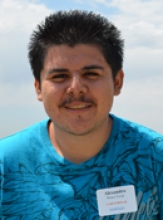 |
Major: Mechanical Engineering
Home City: Los Banos, CA
Contact: apereztovar@ucmerced.edu
Faculty Mentor: Professor Gerardo Diaz
|
Alexandro Perez-Tovar is a fourth-year undergraduate student in mechanical engineering, researching alternative forms of sustainable energy focusing specifically on sustainable plasma gasification. He expects to graduate in Spring 2014. Alexandro Perez-Tovar was born and raised in the Central Valley, specifically Los Banos. He is a first generation Mexican-American and also the first of his family to attend a university. Alexandro’s lifetime goals include obtaining a master’s degree in the field of sustainable energy.
Design, Fabrication and Calibration of Orifice Plate for Flow Measurements in Plasma Gasification System
Alexandro Perez-Tovar and Professor Gerardo C. Diaz, School of Engineering
With an increasing problem of waste management and the continuous depletion of fossil fuel sources in our world, researchers are looking at different methods of alternative energy. Current research in plasma gasification shows that it is a strong candidate for managing waste and converting it into an alternative fuel source known as syngas -- a hydrogen and carbon monoxide mixture. However, to fully understand if the system can be utilized as a solution, several parameters must be determined to calculate the mass and energy balance of the system, as well as the efficiency. This was done by first measuring the flow rate of the syngas produced using a calibrated orifice plate. Knowing this parameter is the essential first step in aiding to finding the efficiency of our system and whether it is a strong candidate for converting waste to energy. In the continuation of this research we will also be looking at the rate at which the biomass waste is gasified in the system and the amount of steam being generated.
Marco Antonio Rodriguez
Marco Antonio Rodriguez is a third year bioengineering student born and raised in Merced County. He expects to graduate in 2015 and is considering an M.D. or Ph.D. program. He hopes to become involved in multiple hereditary exostoses research in the future because it is a hereditary disorder in his family and the undergraduate research opportunity can be a segue to this goal. As a hospital volunteer and a Yosemite Leadership Program member, he is also passionate about health and leadership. Marco became the older sibling in his family after his sister passed away from cancer in 2008. In his free time he enjoys playing soccer with his two younger brothers. Marco Antonio's research project was made possible by funding from the Pre-Health Scholars Program.
Title: Fabrication, Micro-patterning, and Optical Analysis of Polymeric Electrospun Nanofibers for Biological Applications
Marco Antonio Rodriguez1, Harry Calvin Cramer III1,3, Selena Romero2,3, Venu Polineni3 and Anand Gadre3,; 1School of Engineering, 2School of Natural Sciences, 3Stem Cell Instrumentation Foundry
Biological applications have a need for the development of artificial scaffolds capable of recreating the conditions necessary for bone tissue regeneration. The procedures for creating such scaffolds require the fabrication and patterning of nanoscale polymeric electrospun fibers. Our current research project at the Stem Cell Instrumentation Foundry (SCIF) will focus on the development of such scaffold with nanofibers composed of SU-8, an epoxy based negative photoresist. The electrospinning process is a simple, versatile, and widely used method of producing nanofibers by applying a high voltage (typically 5-30 kV) to create an electrically charged jet of a polymer solution, which solidifies to leave behind a polymer fiber. After electrospinning of the photoresist, the samples will be soft baked in an oven. The soft baking step is followed by lithographic patterning using contact aligner (Quintel© Q-2001 CT Mask Aligner SOP ). In this work, we aim to show that the electrospun photodephynable polymer retains its photoresist properties and that it can be directly patterned in various forms by photolithography. We will perform the optical analysis of the patterned nanofibers via the usaged of the confocal microscope (Nikon Eclipse EZ-C1), and then functionalize such patterned samples by adhering cells onto the fiber surface. Correlation of cell differentiation and proliferation with respect to the topography of the patterned nanofibers will be analyzed for scaffolding as well as implantable medical device applications.
Adolfo Rojo
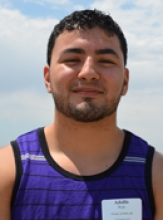 |
Major: Material Science and Engineering
Home City: Lamont, CA
Contact: arojo3@ucmerced.edu
Faculty Mentor: Professor Jennifer Lu
|
Adolfo Rojo is a senior in material science and engineering, and is currently researching the potential of 3D ZnO nanostructures as electrodes for a more powerful, ecofriendly battery. He is the youngest boy in a family of 13, volunteers on weekends and is the treasurer of the Society of Hispanic Professional Engineers (SHPE). He enjoys traveling and eating new and exciting foods. Adolfo's research project was made possible by funding from the PG&E Engineering Summer Scholars Program.
Engineering ZnO Nanostructure Anode for Enhanced Cyclability of Ni-Zn Batteries
Adolfo Rojo, Jose F. Flores and Professor Jennifer Q. Lu, School of Engineering
Nickel-Zinc (Ni-Zn) batteries are a green energy solution that combines high energy and power densities utilizing earth abundant materials. However in the Ni-Zn system, the Zn anode material dissolves in the alkaline electrolyte during discharging resulting in low cyclability and eventual disappearance of Zn species. Zinc Oxide (ZnO) nanostructures with high surface area were directly grown on copper current collector substrates using low-cost and abundant materials. The 3D ZnO nanostructures offer large surface area capable of fast rate of plating and dissolution. In this study, to mitigate Zn loss, polymers [poly(acrylic acid) (PAA) and poly(pyrole) (PPy) ] were electrografted on ZnO nanowire surfaces as a protective layer. ZnO nanostructure with and without polymer protection were investigated electrochemically to observe whether ohmic loss, due to the disappearance of the Zn species was, diminished. This method offers a new possible pathway for creating longer lasting zinc anode.
Andrew Siordia
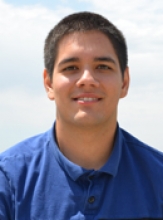 |
Major: Material Science and Engineering
Home City: San Fernando, CA
Contact: asiordia@ucmerced.edu
Faculty Mentor: Professor Vincent Tung
|
Andrew is a fifth-year materials science and engineering undergraduate with a research focus on carbon-based-emulsion-assisted PV-PEC cells for the advancement of solution materials processing. The PG&E Summer Scholars Program has helped sponsor Andrew's carbon-based research for use in solar cells. He expects to graduate in Spring 2014 and pursue graduate study. Andrew has participated in the COINS Program at UC Berkeley contributing to the sensing branch of the Crawler Project through analyzing humidity effects on H2S sensing with integrated Matlab scripts. He has provided dozens of undergraduate engineers with the ability to be young professionals through his position as the professional development chair of the Mu Delta Chapter of Theta Tau. Andrew thinks it is important for students to have every possible opportunity to excel in their fields and professionalism is the start of being a great asset in industry and academia. While not in school, he likes to spend time with his family in San Fernando for the holidays making tamales for several families and also travelling to different parts of the United States.
Emulsion Assisted Dimensional Transition of Graphene Nanoribbons for Energy Harvesting
Andrew F. Siordia, Ishihara Hidetaka, Tomas Oppenheim, Jaskirajeet Sodhi and Professor Vincent Tung, School of Engineering
Buckled sheets, such as a crumpled piece of paper, represent a ubiquitous form of material deformation, which can be viewed as elastic sheets that have been strongly deformed by some external forces. The resultant dimensional transition from flat sheets to three-dimensional (3-D) heavily crumpled particles introduces unprecedented materials properties that do not exist in their parent 2-D structures. These include mechanically responsive electronic structures, catalytic properties, and a surface area increase, thus opening up new research avenues for energy harvesting applications. To facilitate the dimensional transition in a controllable fashion, we studied electromechanical coupling at oil/water interfaces in tandem with theory, modeling, and device fabrication in a multi-scale and synergistic manner. Particularly, this research provides a systematic characterization of the evolving electronic structures stemmed from dimensional transition of 2-D nano membranes into 3-D hierarchical architectures through elegant control of the salient mechanical features of the individual atomically thin sheets which can not be achieved in conventional aerosol technique.
Senam Tamakloe
 |
Major: Material Science and Engineering
Home City: Palmdale, CA
Contact: stamakloe@ucmerced.edu
Faculty Mentor: Professor Min Hwan Lee
|
Senam Tamakloe is an upcoming third-year undergraduate student pursing her major in material science and engineering. She expects to graduate in Spring 2015. Her interest in biomaterials science entails elements of medicine, biology, chemistry, tissue engineering and material science to improve life as we know it; along with nanoscience technology which involves the study, manipulation and control of chemical and biological matter on nanoscale. She is interested in working on projects with practical-world applications. Senam’s belief in science and service to her community propelled her to work at AV Hospital as a volunteer, and doing a pre-engineering internship at the City of Lancaster’s Public Works department. Senam works alongside Professor Min Hwan Lee researching electrochemical energy systems (e.g. fuel cells and batteries) due to their scalability and high conversion efficiency, and reversing the electrochemical process in order for the system to be used as an energy generating or storing system. Apart from research, Senam holds the position as the National Society of Black Engineer’s 2013-2014 Academic Excellence where she believes all students can achieve academic excellence, and encourages students, especially freshmen, to have a mentor. Senam enjoys taking road trips around California and plans to attend the Olympics and the World Cup one day. Senam's research project was made possible by funding from the PG&E Engineering Summer Scholars Program.
High Energy Density – Technological Advancements for Renewable Energy
Senam Tamakloe, Yongjie Wang and Professor Min Hwan Lee, School of Engineering
There is a variety of energy storage technologies available or under development. But each technology has some inherent disadvantages that make it practical/economical for a limited range of applications. However, electrochemical energy storage systems such as batteries offer many benefits due to their scalability and energy/power density potential. For further improvement, especially in terms of energy/power density, a better electrode design and development of relevant fabrication processes are necessary. For our research, we utilized the Electrophoretic Deposition (EPD) method to coat various thin films of battery electrodes. We used the EPD to form graphene oxide films, resulting in a coherent contact with the underlying current collector and thus, enabled an enhanced battery performance and durability. After preparing electrodes with this technique, the samples were examined using two different microscopes: Scanning Electron Microscope (SEM) and Atomic Force Microscope (AFM). SEM imaging provides the information on the material’s nanostructure down to ~10 nm resolution. AFM enables visualization of the surface geometry with even higher resolution, and probes the volumetric cycling of electrode films caused by repeated charging and discharging process in liquid electrolyte. Finally, the electrochemical performance was characterized by a battery analyzer, which enables us to measure the charge capacity and life cycle of a given rechargeable battery. I present a series of experimental setup and resulting data, which characterizes the performance of newly prepared graphene-based electrodes.
Teresa Tan
 |
Major: Computer Science and Engineering
Home City: Rowland Heights, CA
Contact: ttan7@ucmerced.edu
Faculty Mentor: Professor Shawn Newsam
|
Teresa Tan is a fifth-year computer science and engineering major. She decided to join a research program during the summer between 2013 and 2014, hoping to gain experience that would bring her closer to her career choice in computer science, assisting people who have technical issues with software programs and/or hardware. Being raised by a single mother, Teresa learned that the greatest contribution a human can make to society is assisting others in solving their problems, helping people make an impact toward a more advanced future. Teresa's research project was made possible by funding from the PG&E Engineering Summer Scholars Program.
UC Merced Visibility Camera System
Teresa Tan and Professor Shawn Newsam, School of Engineering
Due to the pollution, the air quality is terrible in California’s Central Valley. The goal of this project is to create the UC Merced Visibility Camera System based on a high resolution camera system that is able to capture images every fifteen minutes. The images captured using this system will 1) be used for research on image-based pollution estimation and 2) bring public awareness to the air pollution. Key to the project is a publicly accessible website that shows images that have been recently captured by the visibility camera and gives a brief summary of the project’s purpose. The website also displays the current air quality including both the PM 2.5 (particulate matter measuring 2.5 micrometers or less) and AQI (Air Quality Index) values from the California Environmental Protection Agency Air Resources Board. The webpage will contain pictures of good and bad days, reasons for poor visibility, the camera system used to show the results, and links to where some of the data is taken. Contact information will also be provided on the website if there are any questions and concerns from individuals that visit the webpage. The archive of images and pollution measurements will be used for research on image-based pollution estimation.
Joanna Valenzuela
 |
Major: Biological Sciences
Home City: Modesto, CA
Contact: jvalenzuela3@ucmerced.edu
Faculty Mentor: Professor Masashi Kitazawa
|
Joanna Valenzuela is a first-generation college student and a third-year undergraduate student who expects to graduate in Spring 2015 with a bachelor’s of science in the biological sciences with an emphasis in human biology. Her career goals include becoming a doctor and practicing general medicine in her hometown, where she can help underrepresented communities. In her spare time, Joanna enjoys volunteering at the hospital, walking her dogs and spending time with family and friends. Joanna's research project was made possible by funding from the Pre-Health Scholars Program.
Effects of a Type 2 Diabetes Mellitus (T2DM) Treatment Drug and Angiotensin Receptor Blocker on Brain Pathology in a T2DM Rat Model
Joanna Valenzuela, Carlos Rodriguez-Ortiz, Ph.D., Ruben Rodriguez, Professor Rudy Ortiz and Professor Masashi Kitazawa, School of Natural Sciences
Type II diabetes mellitus (T2DM) is associated with an increased risk for developing Alzheimer’s disease (AD), but the exact molecular mechanisms of this connection have not been fully identified. Nevertheless, hypertension and high blood sugar levels observed in T2DM may augment the risk for AD because these conditions have been shown to increase damages to blood vessels, affect blood flow as well as cause an up-regulation on the production and deposition of amyloid-beta peptides, leading to inflammation and other neuropathological changes present in AD. In this study, we investigated whether two FDA approved drugs (exenatide) and hypertension (olmesartan) also protected from neuropathology in a rat model of T2DM. T2DM rats were treated with an angiotensin receptor blocker (olmesartan, 10 mg/kg/day), exenatide (5 ug in diet/day), or both for six weeks. Staining and western blot were utilized to determine whether these drugs had any disease-modifying effects in the brain. The findings showed no significant neuropathological changes, however, rats specifically exposed to olmesartan alone, exhibited a trend of decreasing inflammation. Follow-up studies will be conducted to further explore a possible molecular link between T2DM and AD as well as any impacts of ameliorating T2DM on AD-like neuropathology in the brain these results.
Melissa Williams
 |
Major: Biological Sciences
Home City: Paso Robles, CA
Contact: mwilliams39@ucmerced.edu
Faculty Mentor: Professor Rudy Ortiz
|
Melissa Williams is a third-year undergraduate student, majoring in biological sciences with an emphasis in human biology. She expects to graduate in Spring 2015. Melissa has spent a year as a member of the National Society of Black Engineers learning how to be culturally responsible and excel academically while positively impacting the community. This has led her to aspire to increase the number of African Americans in STEM. In her free time, Melissa enjoys learning different instruments as well as traveling. Melissa's research project was made possible by funding from the Pre-Health Scholars Program.
Urinary Sodium Excretion Decreases In the Early Stages of Insulin Resistance
Melissa E. Williams1, Jacqueline N. Minas1, Ruben Rodriguez1, Daisuke Nakano2, Akira Nishiyama2 and Professor Rudy M. Ortiz1; 1Molecular and Cellular Biology Unit, School of Natural Sciences at UC Merced and 2Department of Pharmacology, Kagawa Medical University, Kagawa, Japan
Type II diabetes is associated with an activated renin-angiotensin system and glomerular damage, contributing to impaired urinary Na+ excretion (UNaV) and volume-dependent hypertension. However, mechanisms contributing to elevated blood pressure (BP) during early onset insulin resistance (IR) are not well defined. Understanding the effects of onset IR to glomerular damage (proteinuria; UTPV), impaired UNaV and BP, 3 groups of rats were studied (n=6/group); 1) non-IR, Long Evans Tokushima Otsuka (LETO), 2) untreated, IR Otsuka Long Evans Tokushima Fatty (OLETF), 3) OLETF + angiotensin receptor blocker (ARB; 10 mg olmesartan/kg/d). Systolic blood pressure (SBP), UNaV, UTPV were measured at 8 and 15 weeks, a time frame for onset IR. At 8 weeks, no differences in SBP, UNaV, and UTPV between LETO and OLETF rats existed. Therefore, OLETF represented a non-impaired phenotype. At 15 weeks, an 18 percent increase in mean SBP in OLETFs associated with a 46 percent decrease in mean UNaV suggests that impaired renal Na+ regulation contributes to onset IR-associated hypertension. Mean UTPV was 107 percent higher than LETO, signifying that impaired UNaV was due to glomerular damage. Conversely, ARB treatment in OLETFs reduced SBP by 18 percent UTPV by 20 percent and increased UNaV 100 percent, suggesting that ARB improves early IR-associated hypertension and proteinuria.
Myriam Zavalza
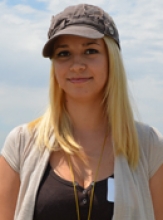 |
Major: Biological Sciences
Home City: Uruapan, Michoacan, Mexico
Contact: mzavalza@ucmerced.edu
Faculty Mentor: Professor Ariel Escobar
|
Myriam Zavalza is a senior working toward her bachelor's of science in human biology and a minor in psychology. Myriam has always been passionate about the sciences and was recruited to join Professor Monica Medina’s laboratory and study endosymbiotic relationships among environmental stressors and impacts on marine organisms. She has been an active scholar participating on poster competitions, science week events and national conferences such as the National Conference of Developmental Biology 2013. She continues to work hard and plans to complete a doctorate degree in the future. Since her passion for science is so big, she is still considering her emphasis for her graduate degree. For the summer, she will work along with Professor Escobar on artificial lipid bilayers. Her ultimate goal is to make herself and her family proud. She is a first-generation student, raised in Mexico, who returned to the United States her junior year of high school. Myriam is an advocate of community service, and is part of various campus clubs and organizations that host such services. She also enjoys traveling and spent a semester abroad studying in Maastricht, Netherlands, and exploring Europe. Next, she plans to visit South America.
Parasympathetic Regulation of Ventricular Action Potential in Murine Models
Myriam Zavalza1, Yuriana Aguilar1 and Professor Ariel L. Escobar2; School of Natural Sciences1, School of Engineering2
The electrical activity of the heart, including the regulation of the heart rate, is differentially controlled by the autonomic nervous system (ANS). Although it has been well established that the vagal innervation of the heart regulates the chronotropism and the excitable properties of the atrium, the role of parasympathetic regulation of the ventricular action potentials (AP) it is still a subject under debate. The experiments presented here were designed to shed some light on the molecular mechanism by which a parasympathetic innervation can regulate ventricular excitability. The principal neurotransmitter in parasympathetic pathway is Acetylcholine (ACh), an ester of acetic acid and choline, which is released locally from varicosities in the synaptic cleft and rapidly degraded by Acetylcholinesterase (AChE), a cleaving enzyme. The role of cholinergic regulation of the excitable properties in the ventricular free wall was asses by performing electrophysiological recordings of Aps in Langendorff-perfused mouse hearts. Intact mouse hearts were perfused with drugs that can interfere/ modulate a downstream parasympathetic pathway. Specifically, hearts were perfused with synthetic cholinergic agonist (Carbamilcholine) and antagonist (Atropine) to definitively establish the role of parasympathetic regulation of ventricular APs. In addition, the turnover of endogenous Acetylcholine release was evaluated by impairing the enzymatic activity of AChE with the AChE-inhibitor Paraoxon. Altogether, the experiments presented in this poster seek to define the role of vagal stimulation on the ventricular function under physiological conditions.
William Zeledon
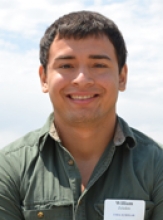 |
Major: Computer Science and Engineering
Home City: Dos Palos, CA
Contact: wzeledon@ucmerced.edu
Faculty Mentor: Professor Ricardo Cisneros
|
William Zeledon is an incoming third-year undergraduate student of computer science and engineering. He has maintained an above-average GPA while also holding leadership positions in several organizations. Within the organizations he strives to work with the community and bring others to participate in community service. William enjoys helping others, especially those in his community. He is also very technologically savvy, continuously looking to upgrade his outdated items to newer and better objects. William's research project was made possible by funding from the USDA Research and Mentoring in Agricultural Sciences HSI Scholars Program.
Sheep Fire Emissions Suggest an Impact on Air Quality in the San Joaquin Valley
William Zeledon and Professor Ricardo Cisneros, public health, School of Social Sciences, Humanities and Arts and School of Engineering
This study investigates the fire emissions of Sheep Fire and determines if the pollutants emitted have an impact to air quality in the San Joaquin Valley. Forest fires in the western United States have increased in size and intensity leading to bigger impacts on air quality. This increase is believed to be in part created by fire suppression activities implemented at the beginning of the century and warming of the earth caused by Green House Gases (GHG). According to the San Joaquin Air Pollution Control District forest fires impact air quality by emitting great amount of pollutants. The pollutants emissions presented here are: carbon monoxide (CO), methane (CH4), ammonia (NH3), oxides of nitrogen (NOx), sulfur dioxide (SO2), volatile organic compounds (VOC), 2.5µm particulates (PM2.5), and 10µm particulates (PM10). Data was collected via the California Air Resource Board, and other databases. We used ArcGIS and the BlueSky Playground model to create emission estimates for spatial and temporal analysis of the Sheep Fire occurring in Kings Canyon National Park and Sierra National Forest 7/29/2010-10/01/2010. We conclude that the Sheep Fire emitted large amounts of pollutants comparable to 5.61 percent of California’s 2008 annual emissions. Fire emissions of Sheep Fire contain large quantities of pollutants that are dispersed into the sky, which can have a lasting impact to air quality.
Ana Zivanovic
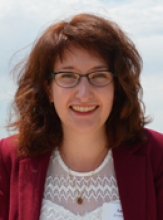 |
Major: Environmental Engineering
Home City: Alameda, CA
Contact: azivanovic@ucmerced.edu
Faculty Mentor: Professor Elliott Campbell
|
Ana Zivanovic is a fourth-year undergraduate student studying environmental engineering and is exploring the Hestia approach, a method of spatial analysis used to analyze the carbon emissions on a building point basis. With the decision to take a fifth year and graduate in the spring of 2015, Ana plans to continue preserving a proficient academic standing by doing well in her classes and pursuing further research opportunities in the areas of hydrology and energy and sustainability. At the same time, Ana hopes to maintain her campus leadership titles such as chief justice in student government and committee leader for the annual, student-run You See Leaders Conference. Instinctively shy, being able to gain the respect of her university peers has been life changing for Ana; spending most of her childhood summers in Serbia, making friends was easy, yet upholding friendships proved to be difficult. Using her diverse cultural experiences, linguistic skills and extensive background in the liberal arts, Ana desires not only to enter the work force as a well-rounded individual, but also serve as a mentor to other students emerging into the fascinating field of engineering. Ana's research project was made possible by funding from the PG&E Engineering Summer Scholars Program.
Parcel by Parcel Toward a More Refined Carbon Emissions Estimation for Livermore
Ana Zivanovic1, Andrew Zumkher, master's of science2 and Professor J. Elliott Campbell1; 1School of Engineering, 2Environmental Systems Graduate Group
Carbon accounting has become imperative in instituting regulations, developing major policies, and in expanding urban metabolism research. For years, city agencies have reported carbon dioxide equivalent (CO2e) emissions across large spatial distributions (city scale). More evidence, however, proves that focus should be turned towards higher spatial resolution estimates (ie building scales). Still, how effective are these high-resolution estimates in comparison to city-scale investigations? Do they represent how each sector contributes through the use of natural gas? There have been few attempts to conduct such high-resolution bottom-up emissions analysis, the most refined being performed by the scientists behind the Hestia Project. For this project, an approach related to the Hestia method was applied to the city of Livermore. Residential sector emissions were estimated by down-scaling the 77 Livermore neighborhoods using a variety of geospatial datasets for modeling area; carbon emission sets per household were estimated for the Western United States by the United States Energy Information Administration. Results suggest natural gas upper-level estimations of 201,644 metric tonnes CO2/year, while findings show that making utility statistics and analyses available to the public is crucial in further exploring energy consumption.







